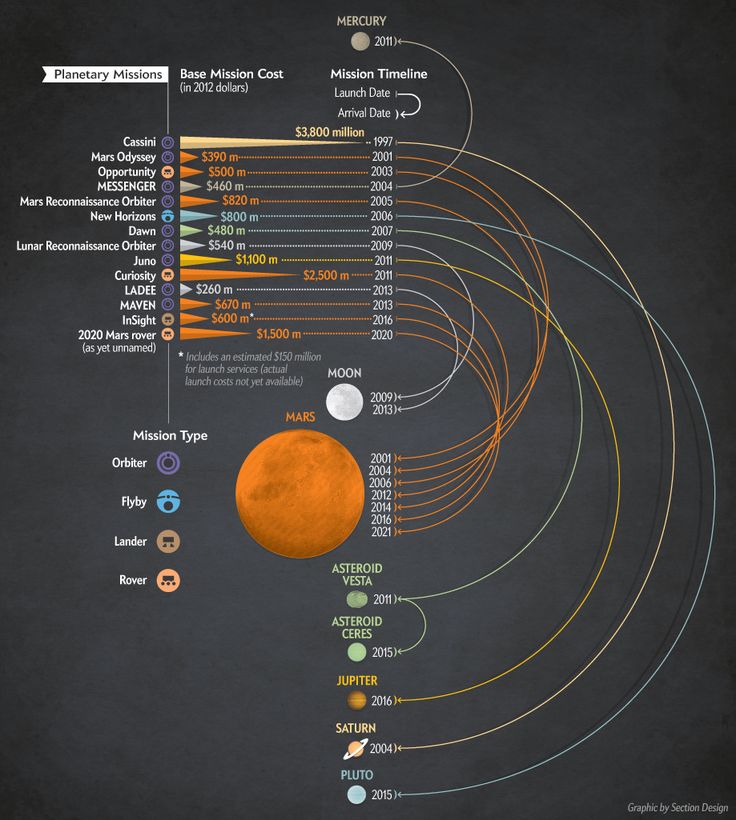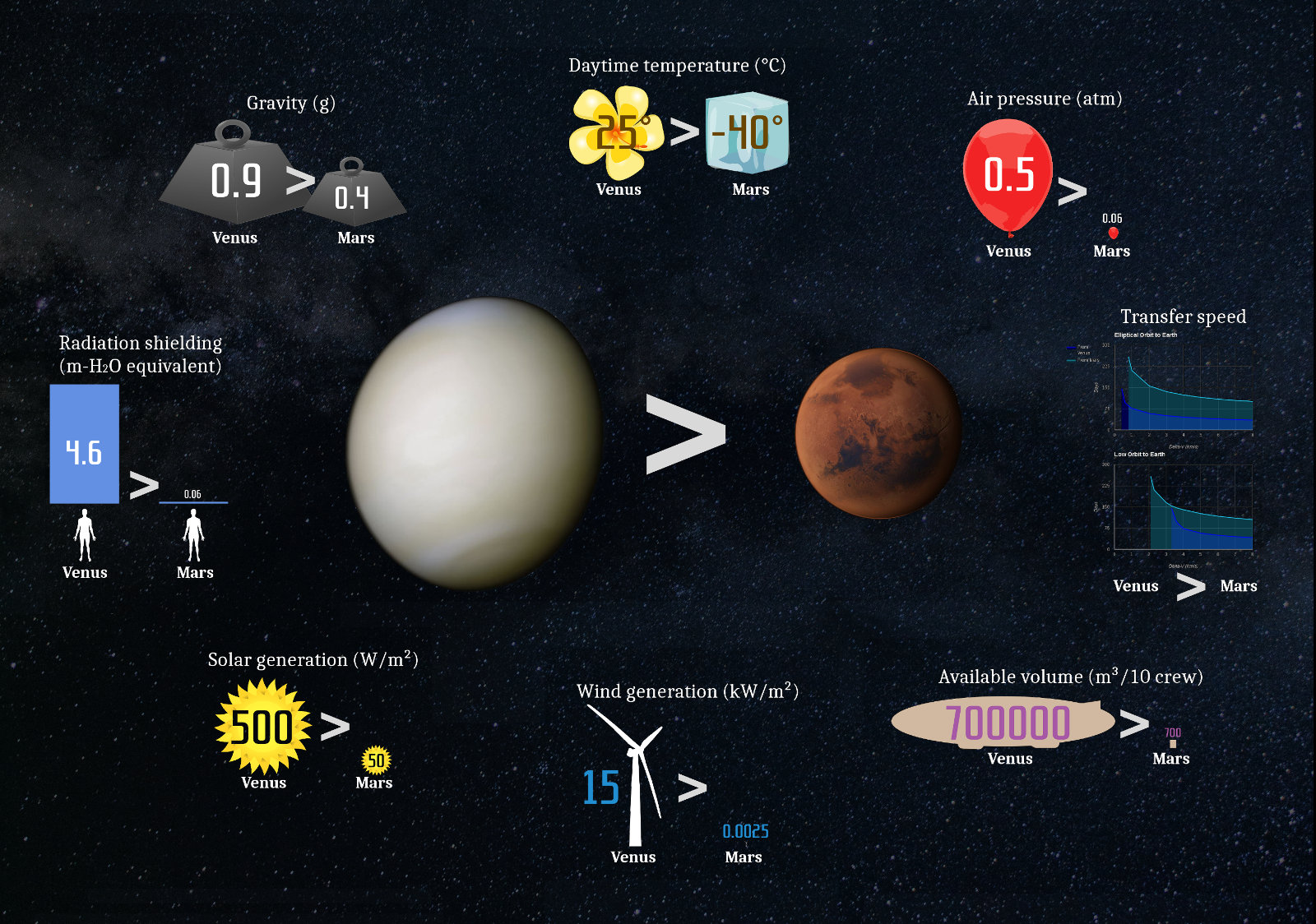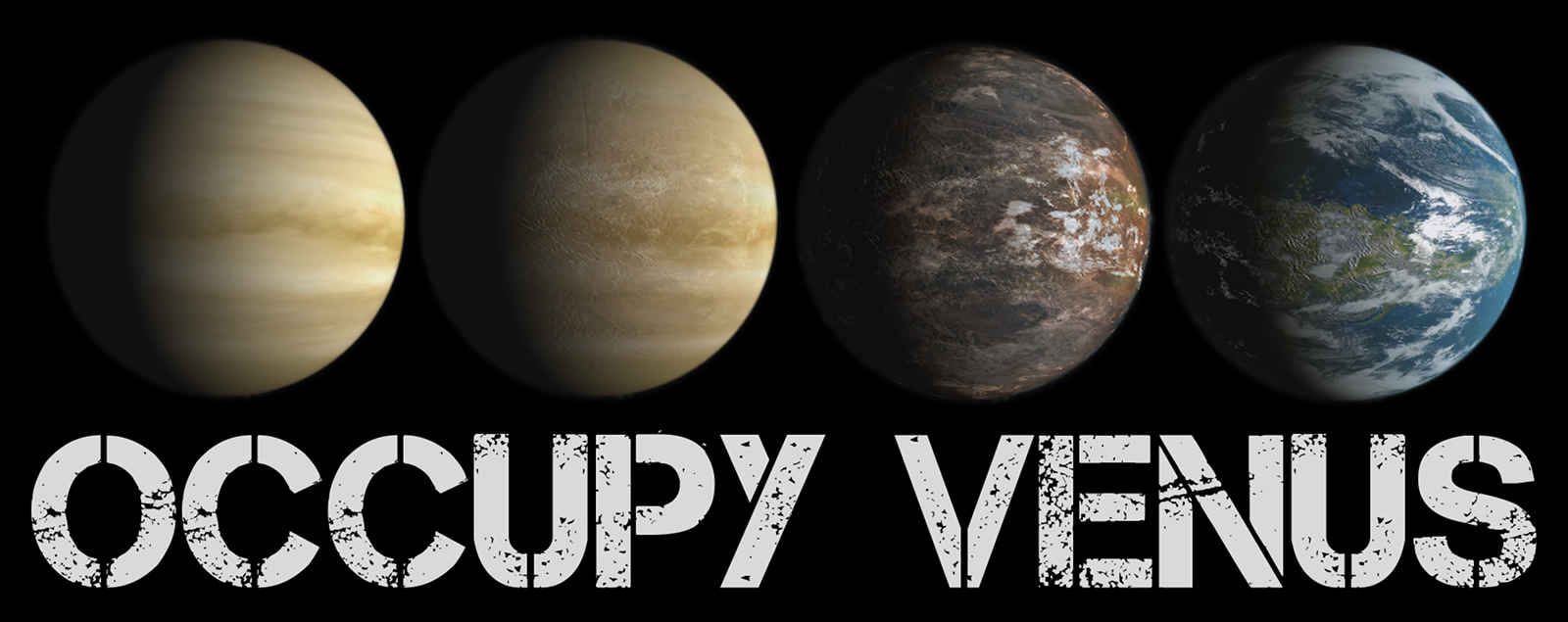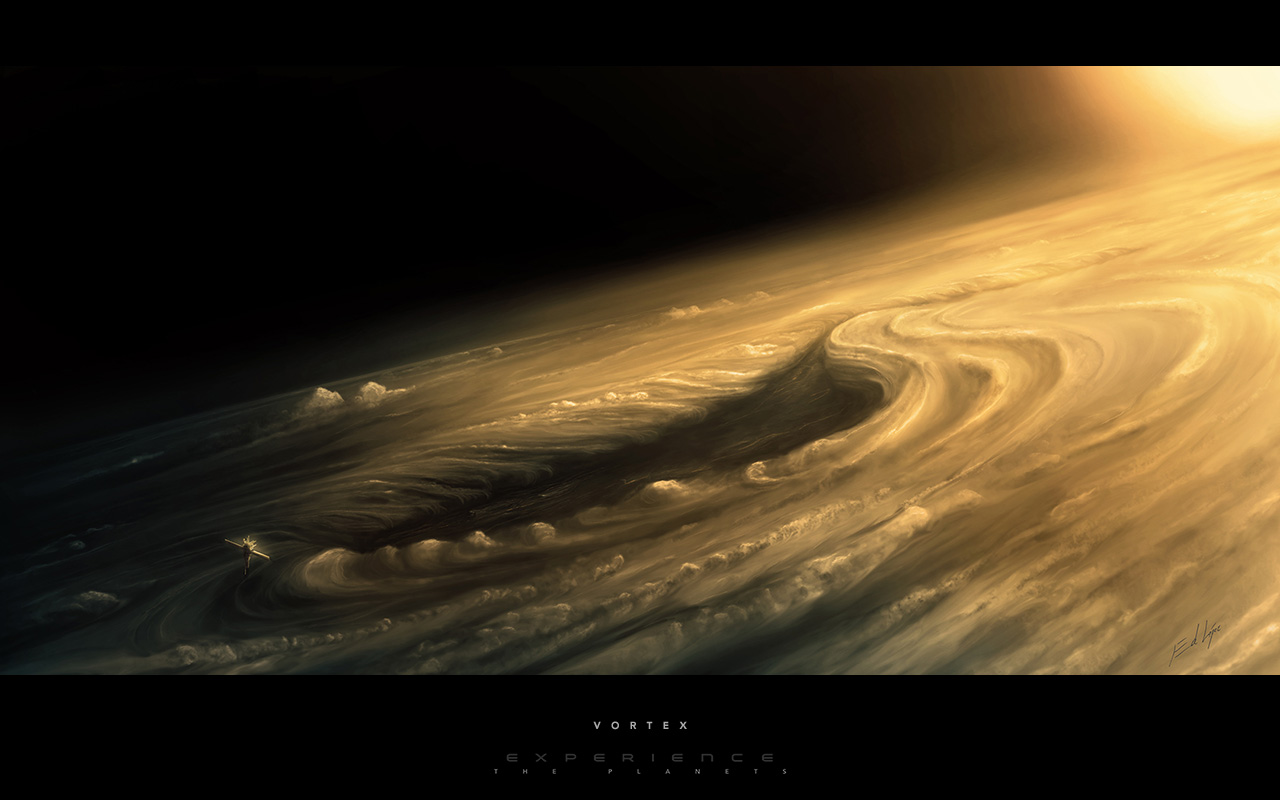
Why Explore Venus?
When it comes to planetary exploration, Mars certainly has done well for itself.

Graphic by Section Design
With missions to the Red Planet launched once every few years, Mars has taken for itself the lion's share of NASA's planetary exploration budget. Also receiving various degrees of attention are the Moon, Mercury, asteroids, Jupiter, Saturn, and Pluto. Strangely, Earth's wayward twin, Venus, does not appear on that list.
To be fair, the above graphic only begins in 1997. This raises the question: when was the last dedicated NASA mission to Venus that was more than just a distant flyby? Surprisingly, you have to reach all the way back to 1989, when Magellan probe was launched to radar map Venus. Even that was over a decade after the previous NASA mission to Venus, the Pioneer Multiprobe.
Despite being the easiest planet in our solar system to reach, Venus seems unable to draw any attention. After confirmation that its surface pressures and temperatures rendered it a veritable autoclave, NASA seemed to lose interest. Indeed, Venus proposals continue to lose out to other competitors. In 2017, the winners of the 2015 Discovery Program were announced. Of the five finalists, two were Venus probes. Neither were chosen.
Is the problem that there are no compelling scientific questions to be answered? Quite the opposite. While Mars has been explored extensively, Venus is a wealth of unanswered questions (many of them laid out by VEXAG in detail). Determining the reason why a planet that formed in seemingly so similar of a manner to Earth ended up so radically different is critical to understanding the fate of our planet and the formation of other Earthlike worlds elsewhere in the universe. Without a solid understanding of the evolutionary characteristics that led Venus on its path, we can only speculate on the nature of the wide range of extrasolar planets which continue to be discovered. Describing Venus's past as "Earthlike" is no exaggeration; the planet was once covered in vast seas, as extensive as Earth's. Yet today, its deuterium ratios tell the tale, of Venus's transformation from paradise to hell. Clues to its past, perhaps even surviving ancient crust, are believed to exist in its highland terrae - yet to date we have not landed a single craft there, and more to the point do not even know what type of rocks they are made of.
"Not knowing what things are made of" is an understatement for Venus. Many parts of Venus's highlands are covered in highly radar-reflective frosts, potentially multiple types. Speculation as to the material's composition have ranged from iron pyrite to galena to tellurium. Strange volcanic and tectonic features like arachnoids and tesserae have likewise never been visited. The longest riverbed in the solar system, Baltis Vallis, lies on Venus - yet we don't even know what carved it. Our best hypotheses are strange in their own right, such as thermal erosion from carbonatite or kimberlite lavas.
Venus's superrotating atmosphere is just as poorly understood. Its cyclone-like polar vortices have never been visited. Lightning exists on Venus, apparently at least as common as on Earth - yet we have never seen it, nor do we even know where it occurs or why. We do not know what kinds of precipitation occur on Venus, of what compounds, or even whether precipitation accumulated on the last probes to Venus's atmosphere (Vega) or not. We do not know what compound is heavily absorbing UV in Venus's atmosphere - a debate rages between polysulfur compounds and iron chloride. It's been strongly argued that Venus's lower cloud layer contains great quantities of phosphoric acid, yet this is uncertain. Venus's mercury inventory should exist in its atmosphere in significant concentration, yet measurements so far have constrained it to orders of magnitude lower than calculations suggest. To call our understanding of Venus's atmospheric dynamics poor would be to overstate the case.
Every advocate for every destination in the solar system wishes that their chosen location would receive more attention. But Venus's combination of poor exploration, significant unanswered questions with direct applicability to our own planet, and easy accessibility make it a standout. It has long since come time to reverse the decades of neglect and give our sister planet the attention that she deserves.
Why Settle Venus?
Perhaps the greatest challenge that the settlement of Venus faces is incredulity. With a hellishly-hot surface under a crushing atmosphere, how could a manned settlement be remotely plausible? Yet far above the surface in Venus's sparse middle cloud layer lies the most earthlike realm in the solar system - a place well suited to human habitation:
|
|
|
|
|
|
|
|
|
1
|
0.38
|
0.17
|
Very low
|
0.9
|
|
|
1
|
0.006
|
0
|
0
|
0.5
|
|
|
25
|
-40
|
-25
|
Usually low
|
25
|
|
|
8-15
|
90
|
300
|
Very high
|
15
|
|
|
24
|
24.5
|
336
|
Widely varied
|
48
|
|
|
Moderate
|
Low
|
Low
|
High
|
High
|
|
|
10.3
|
0.06
|
0
|
0
|
5.3
|
|
|
25-65 μT, intrinsic
|
Weak, induced; 20-40 nT MPR, 5-20nT magnetosheath
|
None
|
None
|
Weak, induced; 40-80 nT MPR, 10-40nT magnetosheath
|
|
|
Those which humans evolved to
|
Fine, abrasive dust / silicosis; perchlorates; chromium(VI)
|
Highly abrasive dust / silicosis
|
Highly abrasive dust / silicosis
|
Corrosive acid mists; numerous known and theorized chemicals
|
|
|
Those which humans evolved to
|
Marsquakes; landslides; dust storms; solar storms. Others?
|
Moonquakes; landslides; solar storms. Others?
|
Solar storms. Outgassing? Landslides? Poorly quantified.
|
Lightning? Gusts / shear? Icing? Storms? Limited data.
|
|
|
Not applicable
|
Category IV
|
Category II
|
Category I to II
|
Category II
|
|
|
0
|
4.5
|
6.1
|
As low as 3.8, but usually well more
|
3.5
|
|
|
10.1
|
5.9
|
5.6
|
Low to extremely low
|
11.8
|
|
|
0
|
9
|
0.1
|
Widely varied
|
5
|
|
|
0
|
25
|
Several days per month
|
Widely varied
|
19
|
|
|
Available
|
Available
|
Absent
|
Absent
|
Available
|
|
|
Significant
|
Limited
|
Absent
|
Absent
|
Significant
|
|
|
Present
|
Present
|
Present
|
Present
|
Not approached
|
|
|
290
|
~50, up to 129; sometimes almost none
|
400 (but two weeks w/o light)
|
Widely varied
|
500
|
|
|
Moderate
|
Effectively none
|
None
|
None
|
High (tethered turbine)
|
|
|
Baseline
|
Probably moderate to low
|
Probably low
|
Low
|
Probably high, but arid
|
|
|
Moderate
|
Probably moderate to low
|
Moderate to low
|
High
|
Probably high
|
|
|
Moderate
|
Moderate
|
Moderate
|
High but hindered by microgravity
|
High atmospheric, low surface
|
Details of the above graphic can be found in Rethinking Our Sister Planet: A Handbook For The Development Of Venus, ch. 1.
While the concept of a floating colony on Venus has received some prior attention, a real focus began after the publication of Colonization of Venus by Geoffrey Landis (NASA / Glenn Research Center) in 2003. Landis, while researcing the potential to loft aerobots in Venus's atmosphere, noticed that the easiest gases to produce via in-situ resource utilization (ISRU) are nitrogen and oxygen - the main components of breathable air on Earth. However, on Venus they act as a lifting gas, with half the lifting power of helium on Earth. In short, a human crew could live (and cultivate crops) inside the very envelope that keeps them aloft. Furthermore, the available lift can be quite large; a city-sized habitat has enough lift to loft an entire city.
Other factors make Venus quite appealing beyond its Earthlike nature. The planet is blessed with an abundance of energy, both solar and wind. Its atmosphere is a rich cocktail of resources, separated into different layers, while its unusual surface environment offers interesting mineralization possibilities. Even the sparse sulfuric acid "smog" is more of a resource than a curse - while easily tolerated by a wide range of polymers, it can be decomposed to water and sulfur trioxide by heating - and with further heating over a vanadium catalyst, sulfur trioxide decomposes to oxygen and sulfur dioxide. Hence this one resource alone can provide two of the most essential resources needed for life: water and oxygen.
From an orbital dynamics perspective, Venus is in a superb location. Minimum energy transfers from Earth to Venus are similar to those to Mars, but travel times can be made much shorter. Return trips from Venus are far quicker than from Mars. The high Oberth effect at Venus makes trajectories to the asteroid belt and outer solar system more easily accessible from Venus as well.
While there is much going for Venus, it does present some downsides. Its Earthlike gravity, while good for human health, makes it more challenging to reach orbit in comparison to other colonization destinations, such as Mars. While the surface is not inaccessible (and has been explored since the 1960s by Soviet probes), it is nonetheless a hostile environment and lies at a significant distance below the habitable zone. While "landing" a habitat on Venus is in many ways much easier than on Mars (having no need to avoid surface obstacles or target a precise location), midair deployment presents new complications. These and other issues certainly must be accounted for, but none appear to be prohibitive for colonization.
Why Not Mars?
It's easy to point out the advantages of Venus over other destinations, such as Mars - for example, for a Venus habitat at 54.5km altitude / 70° latitude versus a typical Mars equatorial settlement:

Details of the above graphic can be found in Rethinking Our Sister Planet: A Handbook For The Development Of Venus.
One could likewise point to aspects for which Mars has the advantage, such as abundance of hydrogen and easier access to orbit. However, space is not a zero sum game where we must choose one target to focus all of our energies on - one can love the moon, Mars, the asteroids, and Venus.
More to the point, when one over-focuses on a particular destination, they can miss out on synergistic opportunities. Orbital transfer stages, local refining and production systems, and numerous other pieces of technology can be shared. The existence of multiple destinations reduces the amount of time in which transfer stages must remain idle on average, waiting for launch windows. Even in the event of a catastrophe on a manned outpost on Mars, the advantageous orbital dynamics of Venus will frequently mean that aid sent from Venus could reach Mars before aid sent from Earth. In the long term, the very different resources available on the two planets presents the potential for trade.
In short, Venus is not a competitor to Mars; it is a synergistic partner. Exploration hardware should be designed with multiple destinations in mind. Venus should - like Mars - benefit from a rigorous programme of exploration, habitat and ISRU systems development, and ultimately - as the technology matures - manned missions.
A Future on Venus

Economics
(see ch. 8)
Venus presents a wealth of potential resources. Deuterium levels, as measured by Venus Express, are 240 times higher than on Earth (3.7%). A massive market on Earth exists for deuterium at $900/kg, while smaller markets exist for heavy water higher enrichments, up to $12000 per kilogram.
Venus's surface (see chapter 8 for details on surface access) shows strong signs of intensive differentiation processes and lavas associated with valuable mineral resources; seven naturally occurring elements currently market for over $10k per kilogram. Gemstones can sell for vastly higher values, with many varieties selling for millions of dollars per kilogram, and the most expensive examples in the billions. The unusual environment of Venus's surface, slow cooling times and heavy differentiation would be expected to be associated with pegmatites of gemstones which are rare - or potentially even nonexistent - on Earth. The global market for gemstones is large, while the exotic pedigree on its own offers high potential market values.
In small quantities, ordinary rocks from other celestial bodies sell for millions of dollars per kilogram. A much larger market exists for decorative stone with rare and exotic provenance. Venera data suggests that Venus's surface contains large deposits of minerals such as troctolite, gabbro (so-called "black granite"), anorthosite (unbrecciated, in contrast to lunar anorthosite), norite, and other minerals with frequently excellent aesthetic and material properties. Labradorite, with a characteristic bluish-purple iridescence, is frequently associated with such minerals.
The "enforced rarity" of locally produced products (agricultural, etc) due to the cost of shipping, in addition to the unique characteristics of the cultivation environment (gas mixture, gravity, day length, etc) implies that such goods should command a premium on Earth. Rare and desirable agricultural goods on Earth can range from thousands to millions of dollars per kilogram.
Venus has an abundance of energy, both wind and solar. Energy can be indirectly exported in a variety of means. Of particular note is the local manufacture of isotopes, with values measured in billions of dollars per kilogram. High-energy scientific research, computation and certain types of electronics manufacture also represent means to indirectly export energy without requiring high export masses.
While Mars can resemble certain badland areas of Earth, Venus offers an environment totally unique to the human experience, and thus a compelling tourism destination. Tourists, housed in a floating garden paradise, could dive into the hellish depths in an atmosperic diving suit, to a world of active volcanology, tremendous tectonic deformation, and where a small metal bellows would allow them to fly through the air, soaring and diving at will.
At a more basic level, the presence of a settlement allows for its funding via visa fees from prospective settlers. This can be seen as analogous to the requirements in many countries that temporary residents must prove their ability to pay their way during their residence period. Wherein local import requirements are minimized, "telecommuting" can also prove financially viable.
Terraforming
(see ch. 10)
As Geoffrey Landis noted in "Colonization of Venus" (2003), the lift available to large habitats can be tremendous: "For objects the size of cities, this represents an enormous amount of lifting power. A one-kilometer diameter spherical envelope will lift 700,000 tons (two Empire state buildings). A two-kilometer diameter envelope would lift 6 million tons. So, if the settlement is contained in an envelope containing oxygen and nitrogen the size of a modest city, the amount of mass which can be lifted will be, in fact, large enough that it could also hold the mass of a modest city. The result would be an environment as spacious as a typical city."
By the time that habitat diameters are measured in kilometers rather than dozens or hundreds of meters, you could loft whole redwood forests. Sculpted landscapes with soil and boulders atop a structural grid. You could, in effect, build an entire new surface over the planet, one habitat at a time - a surface 3.1 times as large as all the land area of Earth. This is, in effect, a form of terraforming. There are, however, other forms as well.
A variety of approaches have been considered by Landis, Sagan, Gillet, Birch and others for terraforming Venus's atmospheric pressure, surface temperature, day length, and water availability. These range from the ineffective (such as blasting the atmosphere away with impactors) to solutions that are functional but involve importing tremendous amounts of mass (such as converting the atmosphere to water and graphite with imported hydrogen, via the Sabatier reaction). Some proposals, however, are perhaps closer term. While spinning up Venus requires unthinkable amounts of energy, a soletta (as proposed by Birch) orbiting on a 24-hour period could block sunlight from the sunward side for half the day, while reflecting light to the anti-sunward side for the other half, simulating a 24-hour day cycle while reducing insolation to Earthlike levels.
Sequestration proposals that involve freezing out carbon dioxide and preserving it appear to be possible, but involve massive-scale engineering. One of the earliest proposals to reduce the atmosphere, by Sagan (1966), involved engineering microbes to sequester carbon and create oxygen. He later rejected his own proposal, on the grounds that the generated hot, high oxygen atmosphere would be explosive in contact with the sequestered carbon; a further blow was dealt to it by Fogg (1995), who determined that the time for Sagan's hypothetical microbes to terraform the planet would be between 11 thousand and 1.1 million years.
Curiously, Venus's surface composition, as determined by Venera - rich in partially-oxidized minerals like FeO - may offer a solution to the oxygen accumulation problem, in that at high temperatures and pressures oxidation to Fe2O3 is rapid. Interestingly, in this regard Venus would be mimicking Earth's Great Oxygenation Event, where cyanobacteria began producing oxygen. Rather than generating an explosive combination of thick carbon deposits and high oxygen concentrations, organic matter was sequestered in banded iron formations (deposited "rust") while oxygen levels climbed slowly over millions of years. While on Earth, such event heralded a great dying, on Venus it could prove a new birth.
No planet in our solar system will likely ever be another Earth. Mars will always have low gravity, while its nitrogen shortage has no simple solutions - but it could still potentially be made into a temperate, breathable, inhabitable world. Venus by contrast, may suffer from its shortage of water, even if its atmosphere can be properly sequestered and sunlight controlled. Yet it, too, could be home - Earth's desert twin.
This is, perhaps, too pessimistic. The first mammals evolved 225 million years ago. Homo sapiens evolved 200 thousand years ago. 6800 years ago the first known permanent structures were built. One hundred years ago horse-drawn buggies outnumbered cars in industrialized nations. The rate of our technological advancement, while highly uneven between technological fields and timeperiods, has been astounding. Perhaps in the future our species will be controlling such energies and moving such tremendous masses as to be able to convert our wayward sibling planets into new Earths - a paradigm to be repeated as our species reaches out into the stars.
If we do not destroy ourselves first, who knows what the future might hold.
Spread the word

Publish

Spread The Word!
Funding follows public interest - and unfortunately, Venus suffers in this regard. Most people for the past half a century have been taught that of Earth's two neighbors, Mars is interesting and habitable, while Venus is an uninhabitable hellscape.
The only way to change this is to advocate for it. Correct the record. Raise the topic in environments where space, science and technology are discussed. Write comments. Send emails. Encourage government, student, and independent projects. Discuss. Engage. The future of human activity with regards to Venus will follow people's interest in Venus, and you can make that happen.
Publish
Research on Venus is crucial both to our understanding our sister planet and to our ability to mount further missions to the planet. News coverage of research also brings Venus renewed public attention, helping raise awareness.
While any research in concerning the VEXAG goals is desirable, Venus Labs lays particular emphasis on research which has direct applicability toward long-term missions within the atmosphere, including better characterization of atmospheric circulation, radiative balance, vertical motion, and meteorology, with a particular focus on hazards (lightning, turbulence) and local resources (including minor chemical species and hydrogen isotopic ratios).
Proposals for missions to Venus are always highly desirable. Particular emphasis is on missions which test long-term survivability, advanced entry concepts, and utilize materials which could potentially be produced via ISRU.
Gallery

Two habitats tether together with drones while thrusting apart to keep the lines taut. While a steampunk aesthetic and fanciful design elements are incorporated, the open "garden" aesthetic of a Venus habitat is emphasized with hanging structures and agricultural activity embedded into structural elements. Artist: Josh Haberman

When low pressure combines with weak coriolis forces at the pole of a planet with atmosphere, a downward spiral of air called a polar vortex can appear. While found on other planets in our solar system - including Earth - this phenomenon takes an unique twist on Venus where polar coriolis forces are almost nonexistent. This curious structure could one day provide a rare glimpse beneath the clouds of Earth's mysterious twin. Artist: Ed Lopez

While Venus's surface faces crushing pressures and high temperatures, it is not inaccessible - even to humans. Manned access requires jointed hard suits (similar to atmospheric diving suits or NASA's AX-series spacesuits), insulation, and heat-absorbing fluids. Due to the high pressures, a person on the surface could fly with a relatively small metal bellows on their back. Artist: Karen Pease
Cofounder & Chief Dreamer
Visual Development Artist
George Wu
Designer/Web Developer
Your name here!
Venus Labs is an all volunteer team. We're looking for help! Especially wanted are communicators, illustrators and designers, scientists and engineers - if you're keen, please contact us!















